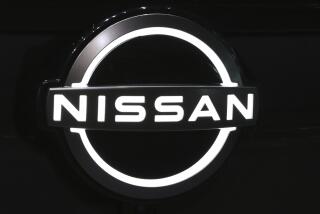Air Bags, Seat Belts Required in Vans, Trucks : Safety: U.S. officials extend the ‘passive restraint’ requirement to the popular minivans, starting in 1994.
- Share via
WASHINGTON — Federal officials Thursday ordered that manufacturers of minivans, light trucks and other multipurpose passenger vehicles begin phasing in front-seat air bags or automatic safety belts starting in 1994--a regulation already in force for automobiles.
Extending the “passive restraint” safety requirement to the increasingly popular classes of vehicles could save as many as 2,000 lives a year, according to Jerry Ralph Curry, administrator of the National Highway Traffic Safety Administration.
Since 1989--when the government began requiring either air bags or automatic safety belts in new passenger cars--thousands of deaths and injuries have been prevented, Curry said.
“Today’s announcement means the same protection will be afforded to the occupants of minivans, light trucks and other vehicles” such as small buses, utility vehicles, motor homes, pickup trucks and four-wheel-drive vehicles.
Excluded from the regulations are walk-in vans and vehicles designed especially for the U.S. Postal Service.
The new requirements did not satisfy consumer groups, however.
“Basically this ruling is too little and too slow,” said Clarence Ditlow, director of the nonprofit Center for Auto Safety, founded by Ralph Nader. Ditlow noted that one of three motor vehicles sold in the United States falls in the “light-truck” category and that more Americans are substituting them for cars.
Ditlow said he also objects to allowing automatic seat belts as a substitute for air bags. The National Highway Traffic Safety Administration has found in test crashes that air bags are 55% effective in saving lives and preventing severe injuries, while automatic belts are only 35% to 50% effective, depending on the belt.
At a Senate subcommittee hearing hours after the announcement of the new regulations, Curry agreed that air bags are superior to automatic seat belts.
Sen. Richard H. Bryan, (D-Nev.)--the sponsor of legislation to require air bags in all cars, vans and light trucks starting in 1995--called the NHTSA’s announcement “a significant step forward.”
But he complained that the Administration has not gone far enough.
“It seems to me that we’re talking about being a little bit pregnant here,” Bryan told Curry at the hearing. “Why not do what we all know is the most important and responsible thing that we can do in America to promote highway safety and simply . . . require the air bags on both the driver’s and passenger’s side?”
Curry said that although he supports the thrust of the Senate bill, he opposes congressional action that undercuts his agency. Curry also said he expects that the aims of the legislation will be realized through voluntary actions by the auto industry.
Ford, General Motors, Chrysler and Honda have already chosen air bags for their passive restraint systems, according to the Motor Vehicle Manufacturers Assn. These manufacturers will include air bags as standard equipment by the mid-1990s, said Thomas Hanna, the association’s president. Although air bags are more expensive, they are more popular among consumers, an association spokesman said.






